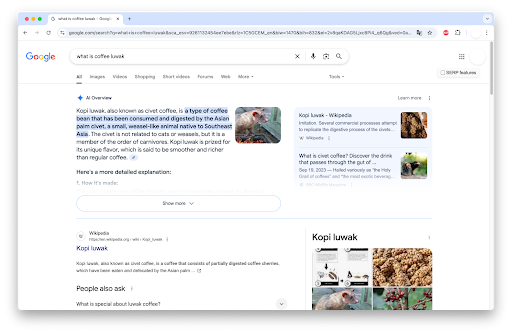After Google’s latest SEO update, I went through analytics for 32 websites belonging to my clients and colleagues. For most of them, things don’t look good: traffic, views and clicks dropped by 10–40 percent. Many of them — maybe you, too — feel like shouting at the search results, “What did I do to deserve this?!” and walking away from the business entirely. Because seriously, how many more crashes in traffic and revenue can we take?
Deep breath, guys. I’m your knight in shining armor, ready to slay AI myths like dragons and carry you into a future where you know exactly what to do with AI.
3 Tips to Adapt to AI Search
- Optimize content for AI scanning.
- Diversify your content.
- Find what works for your business and audience.
I’ve been in content marketing for 16 years. My content studio, WordFactory, has been around just as long. We’ve gone from writing primitive, over-optimized texts to working with top digital agencies and e-commerce companies in Europe and the U.S. We’re copywriters who haven’t been wiped out by AI (though it shook us hard) — and we’ve adapted to the new reality. Let me tell you how, and explain what to do with your content in these AI-driven times.
AI Is Changing the Search Experience
I’m not here to say AI is destroying your site, blog, or content, but I’m also not going to claim it’s had no impact.
Yes, AI has learned how to string words into pretty sentences.
I even remember how just a year ago, some blogs openly stated they generated their content with AI, then edited and fact-checked it manually with experts. But just the other day, I checked one of those blogs — and guess what? The authors are back to good old-fashioned human-written EEAT (experience, expertise, authoritativeness and trustworthiness) articles.
Still, content generation is only half the problem — we can live with that. The real issue is that AI is changing how people search for information and how search engines deliver it. That’s the level we need to be thinking on as content creators.
AI Overviews and Zero-Click results: Search Has Changed. Period.
Now, meet the three horsemen of the content apocalypse. Let’s break down what they are — and what to do about them.
1. AI Overviews: “No One Will Read Your Text!”
AI overviews — now live in the U.S., Europe and several other countries — have stirred up a lot of buzz. If you’re not familiar, they’re the info boxes at the top of Google results that instantly answer your question. You search “what is kopi luwak coffee,” and bam — the answer is right there at the top. No need to click or visit any site. Some data shows that around 60 percent of searches now end without the user clicking through to a website.
Here’s what an AI overview looks like. Pay attention to the right-hand column — those are the sources. We’ll come back to that later.


2. Zero-Click Results: “Google Is Taking Your Readers and Viewers!”
The AI overview text block is just one type of zero-click result. There’s more: videos, images and other formats. SEO used to be about getting to the top. Now, a third, half, or even the whole first page might be made up of zero-click results. That means users can get your info without ever landing on your site.
3. AI Search Engines: “What If Google Is About to Retire?”
There’s an interesting trend with AI search engines. On one hand, they handle informational content well, which is why CTR for non-branded keywords is down 20 percent. On the other hand, they’re still rough around the edges and mess up commercial queries.
Still, AI search is growing fast. Early adopters are already using these tools, and digital marketers are trying to reverse-engineer and game the system.
It’s worth learning how AI search engines work. But let’s not forget: Google still dominates, holding over 89 percent of the global search engine market while ChatGPT accounts for less than 1 percent.
Audience Behavior Is Changing: From Reading to Scrolling
What does it all mean for your audience? People are slowly moving away from reading content. They prefer watching, scrolling, getting inspired, and experiencing things. Travel, food and entertainment queries are shifting fast to social media.
So, what does this mean? Simply that content needs to adapt to new channels and formats.
Is that scary? Let me share my take.
Nothing New Is Happening.
We’ve been through this before. Here are a few key moments we’ve survived in the last 15 years:
- 2010: Keyword stuffing worked. You’d rank just by packing in search terms.
- 2012–2014: Google started requiring clean, structured, mistake-free content.
- 2019–2023: Search engines went all-in on helpful content: long-form, deeply researched, fully satisfying.
And now we’re in the AI era, which calls for yet another shift. But honestly, did things really change only now? Nope.
Even since 2019, text alone hasn’t been enough. Even a brilliant article won’t perform if it just sits on a site (even a great, trusted one) without proper distribution. I’ll give examples below.
What Should Content Creators Do to Keep Up?
1. Go Where the Audience Is
Again, we’ve seen all this before. Content marketing hasn’t died — it’s evolved. It’s become more niche and more specialized.
Take Gen Z, for example. If they want hairstyle or makeup tips:
- 40 percent go to TikTok
- 25 percent to Instagram
- 25 percent to Google.
It’s the same for searches about wellness, fitness, fashion brands, recipes, gift ideas.
And you know what content formats deliver the highest ROI in 2025? Short videos, images, livestreams, podcasts and audio and user-generated content.
So, yes — different generations consume content differently, and topics perform differently on various platforms.
And our job is what it’s always been: follow the trends, go where the audience is, and speak their language.
2. Search Is Still Important.
Almost all AI platform users still use traditional search engines. People can still find your site through search — or discover you via AI Overview. And get this: AI Overview pulls from all kinds of sources. That’s where AI tools learn from.
Here’s a real-life issue where an AI overview cited Reddit as the source.

I’ve seen AI overviews pull info not just from wikipedias or pubmeds, but also Quora, media outlets, and even small personal blogs on LinkedIn.
If AI thinks your little blog on Facebook is trustworthy — and that you are an expert — you’re in the game.
Getting into AI overview today is elite. In fact, some data shows AI overview click-through rate CTR is higher than featured snippets: 12.5 percent vs. 10 percent.
3. Adapt
Here’s how:
- Optimize content for AI scanning. AI Overviews often highlight long-tail queries. Add them to your content, FAQ, interviews — and you might show up there.

- Diversify your content. In our U.S. and EU work, “best of” lists are having a renaissance. Why? Because while AI answers how-to questions well, it struggles with personalized recommendations like “Favorite coffee cocktails” or “Top 10 retro prom outfits.” But it’s not just about articles. Think broader. Use video, interactivity, tools, audio, visuals, games, presentations — you name it.
- Find what works for your business and audience. A niche approach, platform adaptation, content distribution — these are classic content marketing challenges. Like I said, the “I’ve written a great article and waiting for clients” strategy stopped working around 2019. Got a great piece? Awesome! Now share it on Instagram, Quora, Medium, email newsletters, Reddit, LinkedIn, and messengers. Turn it into a video, infographic, podcast. Turn it into a UGC brief or livestream. If you haven’t done that, you’ve lost a ton of audience and money. Harsh, but true.
In content marketing, the key is not to fear change — because it’s always been part of the game.
Today we cringe at over-optimized nonsense articles, but they were once the norm. Today it’s standard to bring in niche experts and do deep research for articles — a few years ago that felt like molecular gastronomy in cooking.
Everything changes. And once you accept that, you’ll breathe easier — and creating content will become more fun again.





